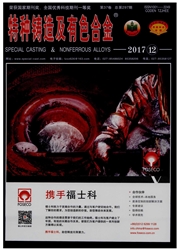

 中文摘要:
中文摘要:
对4mm厚的AZ31B镁合金和Q235钢异种材料进行了搅拌摩擦焊试验,通过金相、扫描电镜、能谱和电子探针沿焊缝厚度方向分析了镁/钢接头界面不同位置的微观形貌及元素分布,并对接头力学性能进行了测试。结果表明,镁/钢接头连接紧密,焊核与钢界面呈"C"字形;沿板厚方向由表面至底部,接头界面由不规则曲线向平直界面变化,中部区域界面钢侧存在元素扩散区;焊接速度为60mm/min时,接头抗拉强随搅拌头转速的增大呈先增后减的趋势,搅拌头转速为600r/min时,接头抗拉强度达到176.5MPa,是AZ31B母材抗拉强强度的67.9%;沿板厚方向分层拉伸时接头中部区域抗拉强度最大,是AZ31B母材抗拉强度的75.3%。
 英文摘要:
英文摘要:
Friction stir welding of AZ31B magnesium alloy with 4 mm in thickness and Q235 steel was conducted. The microstructure and distribution of elements in various interface position between magnesium and steel in thick direction were analyzed by metallographic analysis、SEM (scanning electron microscope)、EDS and EPMA. In addition, effects of process parameters on mechanical properties of the joint were investigated. The results show that magnesium and steel exhibit metallurgical bonding, and the interface between welding nugget and steel presents shape "C". The interface shape is changed from irregular to straight line along the sheet thickness direction from the welding nugget top to bottom. There exists a transition region in the side of steel, which contains both Fe and Mg. With the welding speed of 60 mm/min, the tensile strength is increased firstly and then decreased with the increase of rotary speed. The maximum tensile strength reaches to 176.5 MPa when the rotary speed is 600 r/min, which reaches to 67.9% of strength of the base metal AZ31B. The tensile strength in the middle region of the joint is bigger than that in the top and the bottom region, which reaches about 195.9MPa and 75.3% of strength of the base metal AZ31B.
 同期刊论文项目
同期刊论文项目
 同项目期刊论文
同项目期刊论文
 A new method to accurately describe cross-section distortion in rotary draw bending process of thin-
A new method to accurately describe cross-section distortion in rotary draw bending process of thin- Thermo-mechanical Coupled Analysis of Deformation Behavior in Friction Stir Welding Process of Alumi
Thermo-mechanical Coupled Analysis of Deformation Behavior in Friction Stir Welding Process of Alumi 期刊信息
期刊信息
